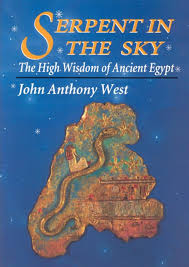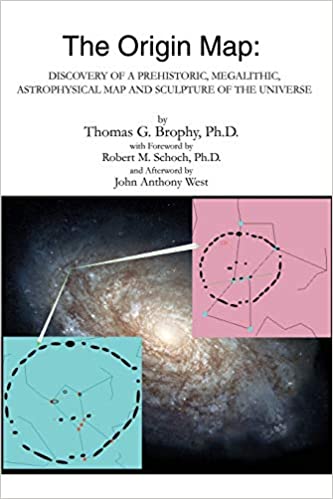Article: ARCHAEOLOGY WARS
ARCHAEOLOGY WARS
Recent attacks on independent researchers,
by an increasingly aggressive party of archaeologists, remind us…
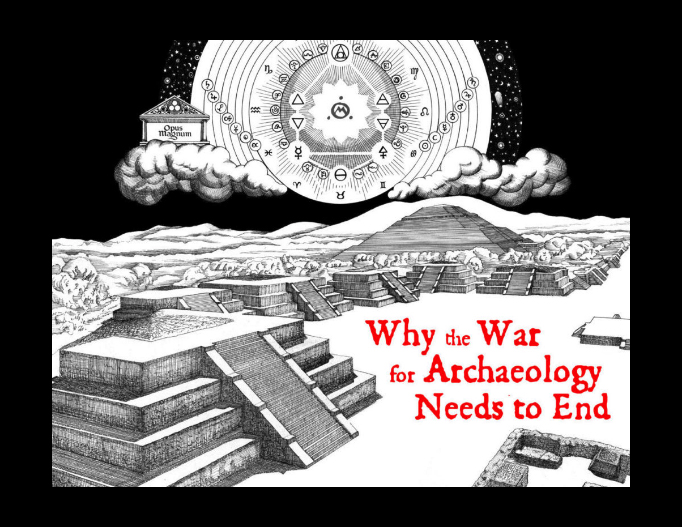
OPVSMAGNUM . ‘ . MMXX
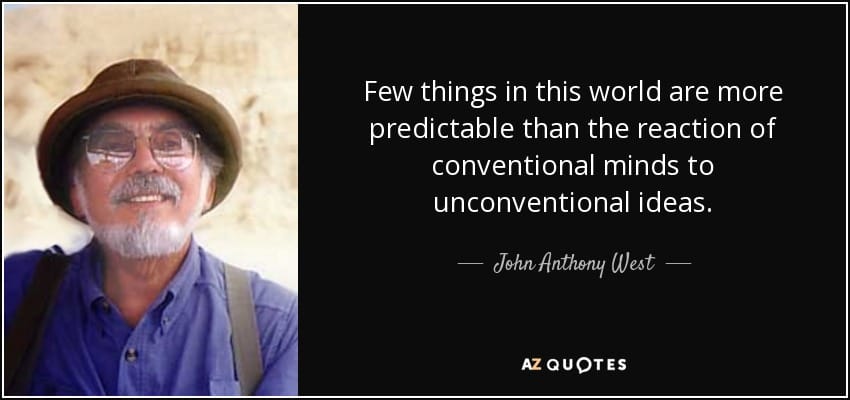
RIP JAW
(All books are links…)
There are many wars in the world that are virtually unknown to all but those who are fighting within them. Some of these are physical wars, which take place in remote regions where sacred lands are being destroyed on behalf of big business, but others are psychological wars. Within the greater psychological war, there is a battle of central importance – that for control of history. There seems to be an ‘official story’ that all academics generally endorse regarding the timeline of civilization’s development, yet many have challenged this timeline with masses of new data and discoveries that prove beyond a doubt that it must be heavily amended if not thrown out completely.
When academia as a whole is put face to face with the questions that many independent researchers have posed, there tends to be an awkward silence, followed by any number irrelevant comebacks. Somehow this situation has grown into a war – as if all academics believe one story and all independent researchers agree to a completely different story. This could not be more inaccurate, though it tends to be the picture that academia has put on the situation.
Just as those who, in the past, have tried to generalize the name of their enemy so as to be inclusive of anyone that disagrees with them (like the terms heretic, terrorist, conspiracy theorist…) so too have certain archaeologists invented a branding for the ‘rogues’ that come around and disrupt their doctrine – the PSEUDOS (pseudo-scientist).
It is my aim to illustrate the validity of certain challenges brought before the universities and to clearly demonstrate that, despite any successful attempt to disprove these theories, scholars have unfairly discounted them from academic consideration. Furthermore, in recent years, many have gone out of their way to slander and ridicule with increasingly desperate and inexcusable attacks.
We can all agree that every theory must be tested by intelligent discussion of many minds. Science is nothing without skepticism, challenges and experimentation. It is necessary to pick these things apart if we are to understand the truth, yet this is not what we see happening. It has gotten to the point at which, if you are paying attention, you can easily see that there is good reason to devote our best minds and scholars towards the questions of real importance in our history, rather than allow an outdated narrative to be promoted.
This issue is of the greatest importance. The evidence has demonstrated that mankind has a far longer and richer history than anyone is allowing us to see. It is PROVEN that the Sphinx and it’s surrounding temples came from a time long before the Pharaohs and discoveries across the world are confirming that in ages long preceding the Maya, the Egyptians, The Druids or the Khmer, there was a connection between all these lands. There was once a level of human sophistication and organization on this planet that may well have exceeded our current state. The Egyptian’s own chronologies record their presence in the land for some 24,000 – 30,000 years, yet because we have all seemingly decided that Egypt was far younger, anyone who suggests the remote possibility that they may have been truthful is a pseudo-archaeologist.
It is important to understand that your mind is the battleground here. It makes sense to trust the scholars who, after all, are specialists, right? It is hard to believe that there could be a conspiracy of universities working to prevent us from knowing the truth about our origins, but that is not (necessarily) the claim. We certainly can not generalize all academics, but we can point the finger at those who are going beyond the line of duty to make this into a fight when it should be a discussion. Several of these ‘professional archaeologists’ have recently attacked many in the field, including myself and several of my friends and colleagues. It is unfortunate that these few tend to hold considerable influence within American archaeology, as they were not able to stand up to the inquiries politely offered to them.
Recent articles by one such ‘scholar’, Carl Feagans, have convinced me to express my view on this subject in some detail. Carl Feagans has personally insulted and censored me as well as many of my friends and fellow researchers. I will explain in detail below, but at the expense of being longwinded, I think it is worth mentioning some context.

There is an almost religious adherence to the law that academics may not consider any research not published in scholarly journals, and for this reason, there are very few scholars that are open to reading the works of independent journalists and authors, who may or may not wish to enter the academic community, but either way, find it difficult to do so. It is a firewall of sorts that has kept the two factions almost completely isolated from one another.
This situation has led to an appalling loss of efficiency in the way we analyze the past. The independents are hurt when the scholars scorn and criticize what they call ‘pseudo science’ and the scholars suffer the fate of watching the ground being pulled from beneath their feet as their cherished timelines collapse, due to new discoveries made by the independents. So the scholars will naturally resist those theories that threaten their very careers, yet they are not ‘allowed’ to so much as consider the work of those who are effectively challenging their model, for fear their reputation and livelihood will be utterly destroyed.
They are not ‘allowed’ to say the word Atlantis. They are not able to speculate whatsoever into the realm of esoteric interpretations, which are the keys to most ancient civilizations. To maintain their rigid standards, they must focus on nothing but facts and figures, avoid speculation at all costs and certainly never loan credence to any of the so-called ‘pseudos’.
In opposition to this, they who chose to approach the study of the past as independent agents, have unlimited freedom to postulate theories and to explore whatever mysteries intrigue them.
Of course, there are benefits to both systems. Where would we be without the orthodox field of archaeology, which over the last couple centuries, has evolved into a massive bank of information, without which, we would have no starting point. Many, if not most, have operated within high standards in the field, and if such standards were not present, then many more of these sites would be damaged irreparably, or artifacts within them might be scattered in ways that prevent us from seeing the original context they were found in. That being said, at no time in history have there ever been anywhere near enough archaeologists or preservationists, in relation to the number of those who violate archaeological sites (tomb robbers, industrial construction, war…), to successfully preserve them. It is wonderful that they might systematically preserve all the pottery shards of single site, but while they have done this ten other ancient sites have been bulldozed.
One would think that a booming interest in the mysteries of the past would lead to a much greater unified effort to preserve all the most significant sites in the world and openly share all data regarding these sites. Well, the archaeological craze did appear in pop culture, especially in the late 1970s and through to the ’90s, but it was a craze generally outside of mainstream archaeology.
ORIGINS of the Archaeology Wars
There were many in the 19th and 20th centuries who carried out groundbreaking work that tended to hint at ages of advanced wisdom in remote prehistory. The concept that in the very distant past, humanity may well have enjoyed a level of intellectual and spiritual sophistication that exceeds that of modern humankind began to take hold. One of the most prolific inspirations for this thesis was Helena Blavatsky and the Theosophical Society, of which, she was a founder. Blavatsky was one of the most influential in this, not only because of the thoroughness and clarity of her language, but also because she was one of the earliest ones to present such ideas to the Western world.
One of the few who came close to this level of influence was Manly P. Hall, who was a great admirer of Blavatsky. His book, The Secret Teachings of All Ages, incited another powerful wave of esoteric and archaeological studies in America, and inspired many to consider alternative views of the past. Edgar Cayce and his psychic readings regarding Atlantis, represented yet another force that pushed alternative theories of history closer to the realm of popular consideration.




The universities and professionals tended to give little attention to such individuals and often tossed them out as rubbish but later on, the ‘rogue journalist’ archetype was born and would bring such studies under the spotlight.
The ‘war’ I speak of did not become so clearly a war until later. In 1979, John Anthony West published, Serpent in the Sky – a thorough account of his work decrypting the deepest layers of esoteric Egyptian symbolism. His work also focused on the Sphinx in particular, proof that it had been heavily eroded in predynastic times. This was a catalyzing event, as John had effectively proven that the Sphinx was far older than anyone believed by drawing attention to the precipitation-based weathering on the monolithic sculpture and on the courtyard walls surrounding it. His thesis was incredibly simple and easy for anyone in the world to recognize. Simply put, the courtyard that was at some time quarried out showed unmistakable, geological evidence of prolonged rainfall and it is well understood that these conditions had not been seen at Giza for millennia before Dynastic Egypt even began.

[Click here for all books by John Anthony West]
The Sphinx is traditionally attributed to Khafre in the third millennium BC, but as John effectively demonstrated, this attribution was based on only three flimsy pieces of evidence;
1) that a statue of Khafre was found buried in the Sphinx temple (which could merely have meant that he worked on the Sphinx, restored it or wanted to put his name on it.)
2) One syllable of his name (Khaf) can be found on the Dream Stele of Thutmose IV, between the Sphinx’s paws (which could at best, again, only confirm that he [or someone else] had something do with it) and
3) That the Sphinx’s face looks like Khafre (which is obviously an opinion and one that John also disproves outright).

This discovery was based on the mention of the weathering in the work of R. A. Schwaller de Lubicz. The Temple of Man, a massive, two-volume book, was the result of de Lubicz’s exhaustive study of the Luxor Temple, where he lived for over a decade. He discovered the ‘key’ to the temple in that he noted it was a massive representation of the human body; more specifically, the divine, male human body. Others have suggested that perhaps the female body was represented at Philae’s Isis Temple or other temples, but until one as ingenious as Schwaller de Lubicz spends a decade on site, we are unlikely know. He measured every wall, pillar, statue and stone and came to understand what is seemingly apparent from one look at the temple – it was the work of those who were FAR more intelligent and aware than practically anyone living today. Whereas the prevailing view of Egypt was that it was a primitive society, one of the first civilizations to rise from the Neolithic Revolution and holding to religious superstitions leftover from barbarians, de Lubicz recognized that the builders of Luxor were much more like proto-Einsteins and Leonardo da Vincis; not glorified cave people.

John West was deeply inspired by Schwaller and when he caught the passing mention of the weathering on the Sphinx, and the implication that it pushed back habitation in Egypt to an entirely different epoch, he realized that this was the evidence that would change everything we know. This was the undeniable evidence that, in one swift move, utterly destroyed the classical, academically-sanctioned timeline. Even still, the implication was far greater than just this.




Not only did construction take place in the extreme distant past, but this is some of the most advanced construction in all of Egypt. The Sphinx is predominately subterranean, meaning the majority of it (it’s entire body) is below ground level. The head is all that extends above the ground. The rest was carved out of the bedrock as the containing courtyard was quarried out. The blocks removed were used in the nearby Sphinx Temple and Valley Temple. This, we are nearly sure of, because we can match the layers of bedrock directly to the stones. This implies not only that the Sphinx courtyard could not possibly have been a natural feature later built upon, but also that some of the most complex stonework in the entire land was executed right there at Giza. The stones in these temples are massive, even by Egyptian standards and are shaped and placed with unbelievable precision. These temples, along with the Giza Pyramids and also the Osirion at Abydos, demonstrate a style of building like nothing else in the land – massive rectangular stones with no reliefs, paintings or hieroglyphs. West speculated that these few monuments may all have come from a civilization in a completely different era.
The release of this discovery made shockwaves throughout the world. His Emmy award winning documentary, Mystery of the Sphinx, narrated by Charlton Heston, aided greatly in bringing his theory before the public.
WATCH THE FULL FILM: https://www.youtube.com/watch?v=SbUsGnMUH2Y&t=5s
I would argue that it was John’s theory that turned the schism into a war, though this was not his intention. He always identified as the little boy in the Emporer’s New Clothes, who stated the obvious to those who were attempting not to see it. The controversy arose in that he was not a credentialed Egyptologist or archaeologist and so the onslaught of criticisms he faced were that much more heated. In fact very few listened to him until he was able to find his needle-in-a-haystack – an open minded geologist. Once Dr. Robert Schoch and his ‘geologist’s eye’ and credentials entered the equation, the archaeological community became extremely defensive and lashed out at both of them. The theory was mocked, laughed off, downplayed and sidestepped. It could certainly not be disproved.
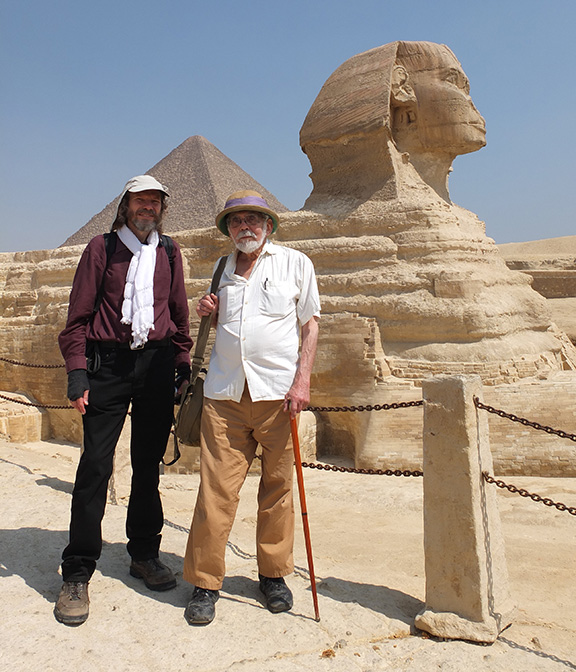
Before this discovery, we were taught that all civilization, more or less, started around 5-6000 years ago. Afterwards, it became clear that some of the most complex constructions on the planet likely originated around 12,000 years ago or potentially far earlier. The weathering proved that the Sphinx was far older than dynastic Egypt but did not pin point its origin date. Two separate sources, however, seem to independently establish that it was built right around 10,500 BC. For one thing, Edgar Cayce stated this matter of factly (but don’t say that to an archaeologist!). At least he said this about the Great Pyramid, though its generally evident that the entire Giza complex was constructed, or at least planned all as a single unit. This implies it was likely all built within the same era. Nevertheless, he states elsewhere that the whole was built as one. The pyramid’s age was requested quite directly to Cayce in a reading from 1932:
“What was the date of the actual beginning and ending of the construction of the Great Pyramid?
Was one hundred years in construction. Begun and completed in the period of Araaraarts time, with Hermes and Ra.
What was the date BC of that period?
10,490 to 10,390 before the Prince entered into Egypt. (Christ)”
– Reading 5748-6
This is a remarkable coincidence as West and others like Graham Hancock and Robert Bauval had been throwing around this exact historical moment as the most likely window for the origin for the Sphinx. They noted that this was the only date at which the Sphinx would be gazing directly at the heliacal rising of Leo, or the date when Leo would rise in unison with the sun, directly in front of the Sphinx’s gaze. It was the dawn of the precessional Age of Leo, which interestingly, is the exact opposite point in the cycle that we are currently experiencing; the dawn of the Age of Aquarius. These are the two ‘Great Equinoxes’ of the precessional cycle. It only makes sense that the lion(ess) would be aligned to the sign of Leo.
The Egyptians demonstrated that they were aware of the precessional cycle, and in fact, held this as some of the most sacred wisdom they possessed. This is a cycle of 25,920 years in which the Earth’s axis slowly ‘wobbles’ around in a circle. In effect, it makes the sky appear to turn extremely slowly – at a rate of 1 degree every 72 years. Having cut the sky into twelve zodiacal arcs, the axis points into each of these signs for about 2000 years. We are currently shifting out of Pisces and into Aquarius. Perhaps this is another reason for the boom in alternative archaeology that came after the hippy generation started to discover what the song Age of Aquarius is all actually about.
Few today are aware of this slow moving cycle and fewer still are aware of the fact that the ancient Egyptians, ancient Meso-Americans and ancient Hindus were all aware of it, though no one has yet provided any reasonable explanation of how this motion could possibly have been detected without advanced equipment. Still less comprehensible is how they could have known the length of the cycle in such precise detail.
In India it is described as the yuga cycle, though it is approximated to 24,000 years. The long count calendar is the Meso-American version. It has been called a Mayan calendar, or Aztec, but the truth is that its origins are unknown. It appears to have been a relic from one of the earliest cultures in the region – likely Olmec. The ‘great cycle’ was approximately 5,125 years and in the center of the calendar are four figures surrounding a central one, signifying that we are in the fifth and final ‘great cycle’ within a still greater cycle. This greater cycle then, is approximately 25,625 years – quite close to 25,920. So the end date of 2012 marked the end of this long cycle and it marks a significant moment within the cycle as it is the ‘great equinox’ of sorts. It is the point at which our solar system crosses the ‘Galactic Equator’ (also called the ‘photon belt’). Both the long count calendar and yuga cycle describe this as a pattern that directly affects humanity. The yugas ascend and descend from a golden age to a dark age and back again eternally. The Hindu cosmology describes cycles of time whole orders of magnitude beyond this as well. In ancient Babylon as well we find these massive numbers, time periods, cycles that tend to describe the lowest common denominations of our solar system. They are numbers that use harmonics geared into the orbits, conjunctions and rotations of all the bodies in our Solar system. One of the most fascinating, in my opinion, is the Ninevah Constant, but this is too great a diversion to explain at present. The point is to establish that this most important cycle played a central role in cultures throughout the world.
In Egypt, at Nabta Playa deep in the Sahara, the ancient masons were able to demonstrate in many ways at once how perfectly they knew the cycle. They built an ingenious stone diorama that featured six stones that self-referenced themselves to six specific stars in two separate groupings – the three stars of Orion’s Belt and the three stars of Orion’s head and shoulders. They set one grouping to reflect the stars at one end of the cycle, and the other to reflect the stars at the opposite end of the cycle. In other words, if we are to believe that they actually placed the stones at the moment when they aligned to their designated stars, then the two groupings must have been placed there roughly 13,000 years apart! At the very least, they could not have even estimated the positions of the stars without accurate records spanning many millennia. Furthermore, they pinpointed the ‘birth’ of each star or its heliacal rising – the one time in the cycle when it rises directly behind the sun – that is to say, they pinpointed six very specific moments within the 26,000 year cycle! If that was not enough, they also demonstrated the relative distances to each of these stars from earth – with stunning accuracy – by placing stones at these relative distances from a viewing stone! Astrophysicist, Thomas Brophy PhD., discovered all of this and so much more, and he gives a detailed description in The Origin Map.
Brophy joined West in his further cinematic dissemination of unknown Egypt, in an eight-part documentary series called Magical Egypt, directed by Chance Gardner. Many other independent research authors were now joining in, bringing shocking discoveries to light. In The Orion Mystery, Robert Bauval presented his Orion Correlation Theory; associating the three great Pyramids to the three stars of Orion’s Belt. This alignment also seemed to indicate the 10,500 BC date which was largely popularized by Graham Hancock in Fingerprints of the Gods and subsequent works. West, Schoch, Bauval, Hancock, Brophy, Laird Scranton and many others collectively pushed their way into academic view. They did not all agree with each other all the time, but they did all agree that serious flaws were becoming evident in the orthodox timeline. They did all agree that these cultures of remote antiquity were demonstrating a genius-level intellect and possessed a highly developed science indicative of an advanced civilization.




The Sphinx Erosion Theory had thrown open the floodgate so to speak. MANY independent researchers stepped into the field, largely inspired by West, the ‘Rogue Egyptologist’. Never before had the theory of a lost civilization in prehistory come so close to the possibility of scientific acceptance or at least consideration.
Archaeologists and Egyptologists were, for the most part, either attacking these theories or ignoring them. No one could disprove the erosion and all the geologists were agreeing that it was clearly a ‘textbook example’ of precipitation-based weathering. The academic viewpoint was largely fronted by Zahi Hawass, who was for a time, minister of antiquities, and permission to conduct research in Egypt often required his approval. John and the others had little success trying to communicate their findings with him. Particularly, (and moreso in recent years) Hancock and Bauval have had issues with Hawass, though West himself actually believed that Zahi was not permanently opposed to the general hypothesis and could come around to the theory if it was shown to him in detail. The public image of Zahi Hawass, to the scholars, is that of a hero. He is the poster child of National Geographic and the Smithsonian and is often called the real life Indiana Jones. To the independent researchers and their readership, he tends to be criticized heavily. He did stall many of these ideas from taking hold. In fairness, he has made some of his own contributions and releases to the field, a qualification not well filled by some of the characters soon to enter this story.
Over the years, suffice to say, Hawass went after Bauval quite a bit and accused him of some significant archaeological crimes, which, in my own opinion, Bauval effectively refuted, yet they are not the best of friends. In 2015, Hancock arranged a debate with Zahi which was well advertised beforehand as part of a tour he was offering. It was big news to both sides of the aisle; Graham was at the forefront of the alternative school and Hawass was primary defender of the ‘status quo timeline’. This is not to say that Graham was representing the views of all independent researchers, but we was intending to fairly represent the data that reflected a general picture of history that many others had been involved in developing. More or less, he was pushing the general argument that, at the very least, we must consider and investigate the possibility that we are forgetting whole epochs of civilization.
Unfortunately, Bauval’s name came up before the debate even began and within a couple minutes Zahi walked out. Hancock accurately acknowledged that Bauval’s work was essential to the overall theory being presented, though it is unfortunate that it came up so quickly. If Zahi had sat down and listened for a few minutes perhaps the mood of the room would have changed, and thus the future of archaeology. Instead, he stormed out in anger and it was all over.
I had considered joining Graham on this tour and witnessing this debate first hand, but I spoke to West about it beforehand and he told me that he was concerned that it may end up simply polarizing the argument further, and he was right as usual. This is not to say it was Hancock’s fault, as I believe he did it with good intentions, but the short exchange was, sadly, a painfully accurate metaphor for the two schools that could not reconcile. It was painful to anyone who had been holding out hope that maybe someday we could all get along. How could this new model ever come to gain the blessing of scholarship and find its way into university studies and high school textbooks if everyone involved was viewing it as a battle?
“First people will deny a thing; then they will belittle it; then they will decide that it had been known long ago”.
– Alexander von Humboldt
The Earth was always flat until it was proven round. All planets orbited the Earth before heliocentricity. Ideas like this take time for society to process. Resistance is to be expected, but at a certain point, denial becomes futile. The key here is that we need to end the war. Academia must come to embrace independent research rather than struggle against it. So often they will not even consider an idea unless it is published in a peer reviewed academic journal, yet they will never allow these theories into such journals. If these subjects were being discussed in universities, then they would ALL be peer reviewed and there would be thousands of intelligent students focused on solving these crucial questions! If the scholars all truly believe that these theories are nonsense, then what is the harm of letting them be discussed? How long could they possibly live under academic scrutiny if they are outlandishly absurd?
The fact that academics have resisted these ideas so blatantly, indicates that they represent a looming, unavoidable threat to everything they hold dear. They feel the winds changing, and though they are the ones who attacked those like John for all this time, I cannot help but feel for them. I wish that they were afforded the freedom to openly consider these ideas without fear of their career ending. I wish it was not considered an act of academic suicide to print the word Atlantis in a journal. The fact is, any student or professor that so chooses, can go ahead and dive into these subjects and if enough of them do, then the tone will change, but there are fear tactics used against them to dissuade this from happening.
A new Breed of Quackademic
There is a sect of ‘fundamentalist-extremist’ archaeologists that is unreasonably aggressive towards any such researchers – a breed coined by West, the Quackademics. They go out of their way to attack these theories with baseless rhetoric and ad hominem arguments. Yet the truth is, this group makes up a very small percentage of scholarship, though they shout very loudly in an attempt to seem bigger. They psychologically influence many in the field to believe that everyone will call them crazy if they so much as consider such things.
In November of 2019, the Society for American Archaeology published an edition of the SAA Record (The Magazine of the Society for American Archaeology) with the theme, “Pseudoarchaeology, Scholarship, and Popular Interests in the Past in the Present”. [Click here to view document]
The large majority of this 52 page publication was devoted to challenging the claims of Graham Hancock’s latest book, America Before. The overall tone of the document was one of fear that the public was paying too much attention to independent theories like Hancock’s. Of course, Graham has been a central target for these attacks for some time, and it seems the archaeological community is growing increasingly tired of his popularity. There is an important distinction to be made when judging Hancock’s work however. His theories DO reach into speculation at times, but when he does speculate, he makes that clear. In other words, there are some things that he is claiming directly with evidence, yet the majority of his work is in the form of questions rather than guesses. Archaeologists tend to miss this important distinction altogether.
Carl Feagans contributed the article, The Cerutti Mastodon, Professional Skepticism, and the Public, in which he states,
“For at least two weeks in May, the New York Times Best Seller list for hardcover non fiction included America Before: The Key to Earth’s Lost Civilization by Graham Hancock (2019).1 Hancock is a British writer who, through several books, claims that there was once an ancient civilization, now all-but-completely lost to us, that was responsible for the monumental architecture of all cultures in the world (Feder 2010). As farfetched as this notion seems, it is well received among consumers of books and media centered on ancient civilizations and prehistory. Part of the appeal of his work for them comes from the antiestablishment tone he infuses effectively within a narrative he creates: “orthodox archaeology” is wrong, and he is right. All this in spite of his lack of formal training, experience, or background in either science or archaeology.”
To claim that Hancock is inexperienced in his field is a bit absurd, as he has been publishing for decades and visiting firsthand all of the sites he writes about. This is not to say he is right about everything, because obviously nobody is, but certainly we can begin to see here how much of the argument is based on ‘lack of scholarly training’, which is not suitable grounds for dismissal, it is an insult to human intelligence. It is to claim that none but those trained in universities have the right to even join the conversation. Feagans also gave a review of the book on Amazon which many of his own followers voted to be a ‘useful’ rating, which throttled the algorithm, making the comment the first one visible, regardless of the vast majority of comments having given the book five stars.
The comment begins:
“I received
Graham Hancock’s new book in the mail from the publisher to review
a little under a week ago as I write this review. I reached out to
St. Martin’s Press back in February and offered to review it and,
although I received a polite response indicating that I’d be
considered, I was somewhat surprised to actually receive it just days
ago, nearly a week ahead of its official release date in the United
States (it’s been available in the UK for weeks now). My surprise
was that the publisher either didn’t vet my previous reviews of
pseudoarchaeology or that they did and were willing to take a chance
anyway.
Having
provided the above disclosure, let me say that though I didn’t
spend money on the book, I will make an effort not to be swayed by
the “gift.”
If you Google the word “pseudoarchaeology” then click the first link, which is probably to Wikipedia, Graham Hancock’s photograph is displayed prominently at the top of that page. If you read this review to its completion, you’ll understand why.”
Feagans admits that he has a pre-existing bias against independent archaeology, which is in fact, quite an understatement. He also must note that he would never spend money on such a book, and this is a typical tone of such scholars – as if it were beneath them to ever sponsor someone for even a couple dollars, who earned their place and paid for their own travel expenses to investigate such things… It is insulting, condescending and certainly unprofessional. Then he begins his dissection by sourcing google and wikipedia..! (Need I say more?) I will not cite the entire comment, but it is still on Amazon’s product page at the time of this writing. [Click here]

In the journal of the Society for American Archaeology mentioned above, Carl Feagans, John Hoopes, Jason Colavito, David S. Anderson and Jennifer Raff all contributed articles warning of the hazardous and dangerous theories of Hancock and the ‘pseudos’, which would seem to imply that the society endorses the militant ban on extra-scholastic hypotheses. The Society for American Archaeology is sending a dangerous threat to all those enrolled in universities who might consider any ‘outside-the-box’ thinking. I recommend reading their papers and deciding for yourself if they are really dedicated to discovering the truth or if they are merely lashing out in jealously at those who have had the boldness to present new ideas which seem possible if not probable. I believe that any intelligent person can discern when they are hearing ‘political-candidate’ responses – AKA many words, saying nothing.
You be the judge: [Click here to view]
Graham then gave a reply to the publication viciously smearing him:
“I can only be grateful to the Society for American Archaeology (SAA), the professional association for the archaeology of the Americas, for devoting no less than 27 pages of the November issue of its journal, The SAA Archaeological Record, to an attack on my 2019 book, America Before: The Key to Earth’s Lost Civilization.
More than an attack, the issue self-admittedly sets out to inoculate students, journalists and members of the general public from contamination by my arguments – tantamount to thought-crimes – that civilization may be much older and much more mysterious than we have been taught.
For a writer such as myself, with a controversial, non-mainstream view of the past, to face pushback on this scale is a sure sign that the archaeological establishment feels the ground moving under its feet. Indeed, Christopher Rodning, the Editor of The SAA Archaeological Record seems to confirm this when he explains his decision to focus on America Before in his November issue: ‘This past year has witnessed the publication of another book by Graham Hancock, the writer and former journalist whose books— 10 since 1992—have sold millions of copies. His literary record makes him one of the major writers in the genre of pseudoarchaeology. It is important for archaeologists to think carefully and critically about what Hancock and similar writers are saying, how they are saying it, and why there is widespread public interest and fascination with it.’”
[Click here for the full response.]
Attempts at live debates, with both conflicting viewpoints represented by many voices at once, have come from the independents often, yet the scholars have never seemed to be willing, and this does not bode well for their case. Here is an example from Feagan’s most recent article, Buzzwords, Bogeymen, and Banalities of Pseudoarchaeology: Göbekli Tepe [Click here to view article]. One of the comments asks;
“… why not challenge Graham Hancock or Randall Carlson to a debate prove your point? The solution to resolve this is straightforward and Graham and Randall both welcome debate. What do you say? A chance to expose pseudoscience?”
Feagans replied:
“Quite honestly, I’m not interested in a debate with these guys. Mostly because I’m not a very good rhetorical debater. There’s a certain amount of quick wit and rhetoric that wins the day in spite of logic and reason. I’d rather engage with the public itself on the merits of scientific discovery and method.”
We shall see very soon what he means by ‘engaging with the public’, but I would note presently that he is essentially saying that he is afraid he may forget how to use words if placed across from Hancock on camera. Sure, many have noted that much of Graham’s appeal, as well as West’s, can be found in their wit and eloquence, but that’s the point – they are writers. I would never shame someone for stage fright, unless they had picked a fight they were unwilling to show up to. This is precisely what we are seeing.
It was this very article (which again attacked Hancock as well as another favorite target of theirs, Andrew Collins) that rekindled my need to speak out against Feagans and relate a tale that happened a couple months ago. This article focuses on Gobekli Tepe, a site in Turkey which, if the reader is not familiar, is one of the most important archaeological sites in the world as it confirms advanced wisdom in remote ages, and within a month’s walking distance of Egypt. I wrote the vast majority of this article then, but decided to let it go until Feagans struck again. Now I’ve decided to publish it.
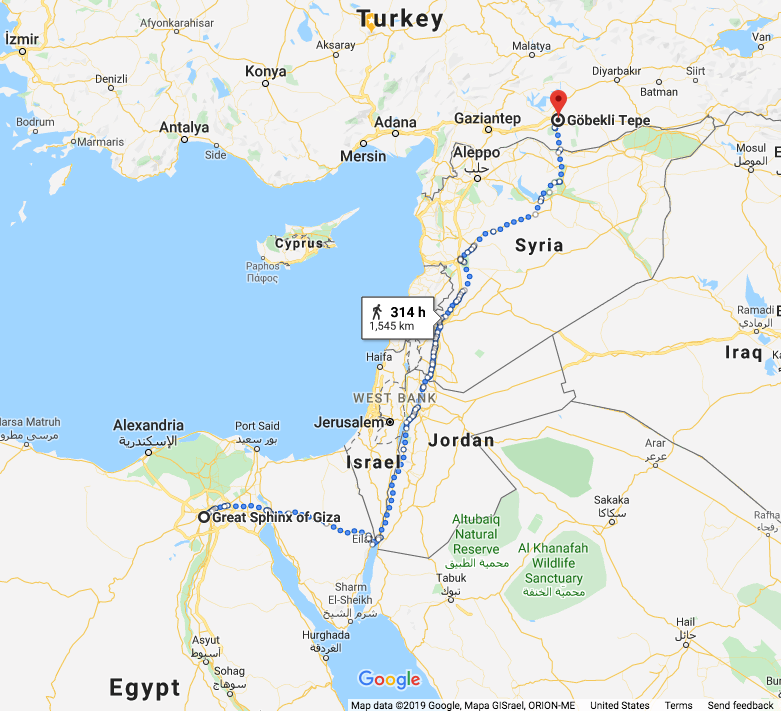
All the contributors to the Society for American Archaeology listed above (Carl Feagans, John Hoopes, Jason Colavito, David S. Anderson and Jennifer Raff) have something else in common as well – they are all members of a Facebook Group called Fraudulent Archaeology – Wall of Shame. If their papers were not enough to convince the reader that their aggressive resistance to such ideas was unreasonable and unfounded, then a quick perusal of this group’s posts will quickly end the debate.
The language used in the group indicates a grade school reading level and many of the comments are so profane and irrelevant that I do not feel comfortable even quoting them. Any who would defend the names listed above in their arguments would do well to have a look at how these characters interact with each other, feed off of each other, stock each other with articles and papers to be used as ammunition and as infants, kick and scream when they are proven wrong.
By their own definition, fraudulent science implies that someone is intentionally misleading others in order to gain status or profits, yet it is plain to see that it is they who are guilty.
My first interaction with them came when Next Anyextee, had noticed that our mutual friend, John Anthony West, had been more or less labeled a “pseudo” and Anyextee questioned this implication. He brought up many valid points and gave thoughtful respectful responses to any questions he received. Eventually, everyone on the page came attacking, and miraculously avoiding the subject matter, sidestepping his call for evidence that John could in any way be considered fraudulent or deceptive in his work.
At a certain point, the admins blocked Anyextee and everyone in the group began to slander him behind his back, when there was no way he could defend himself or even follow the feed. After this, Anyextee posted a response on his own timeline, which despite its length, I feel I should reproduce in full:
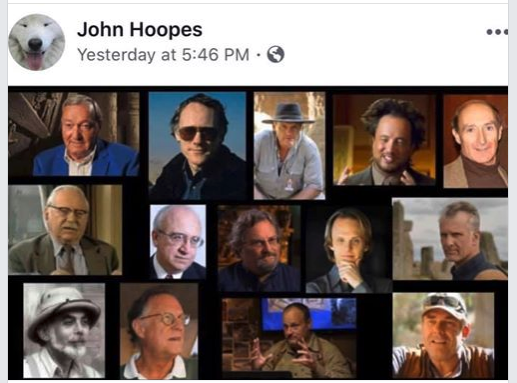
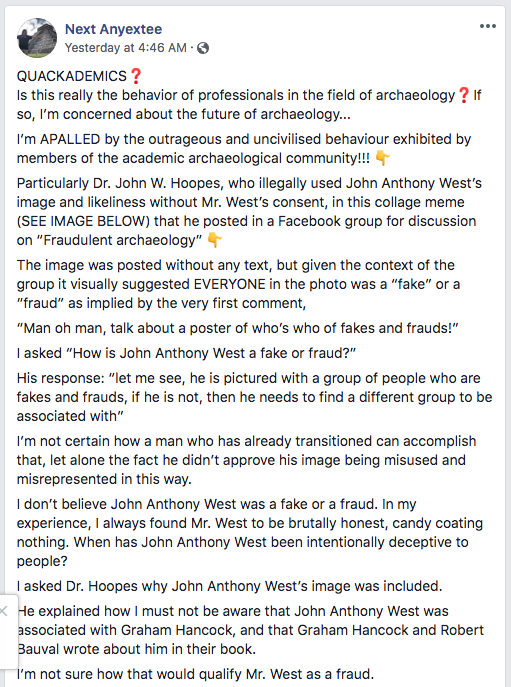
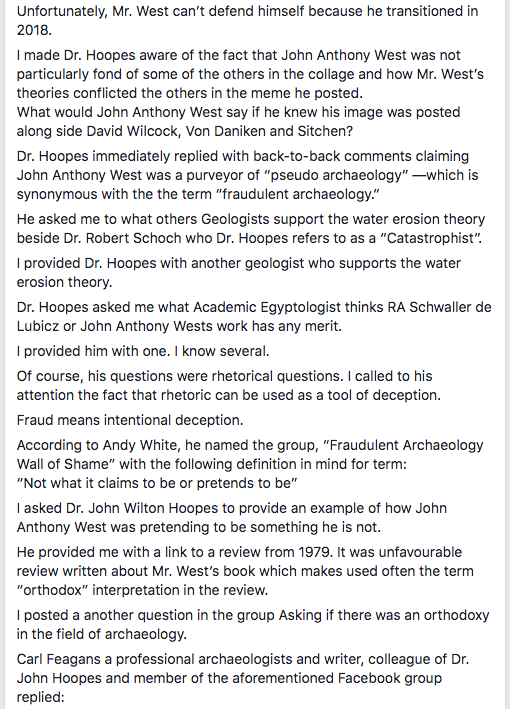
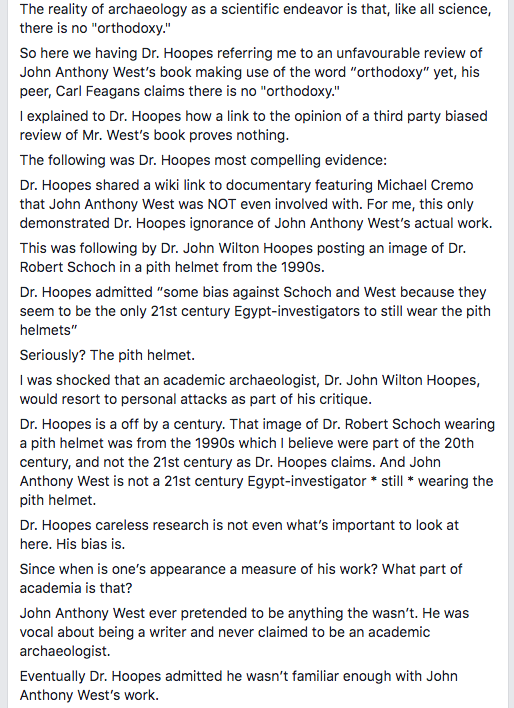
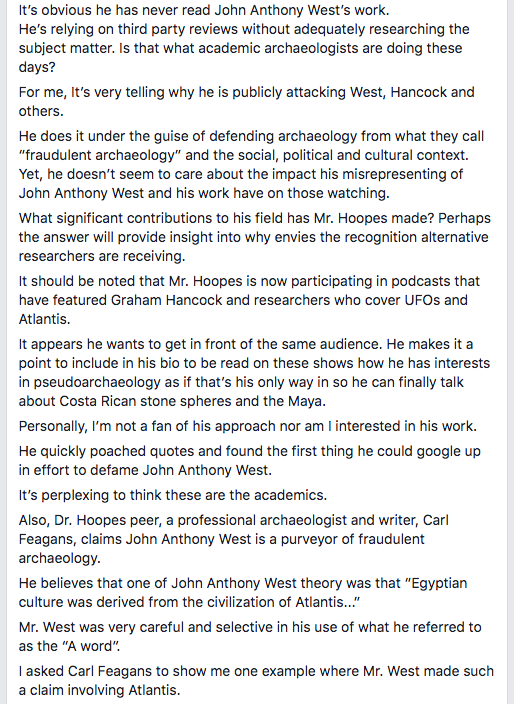
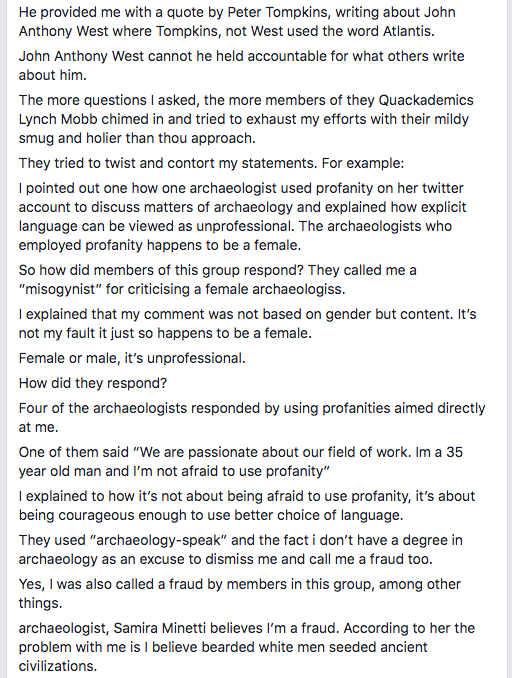
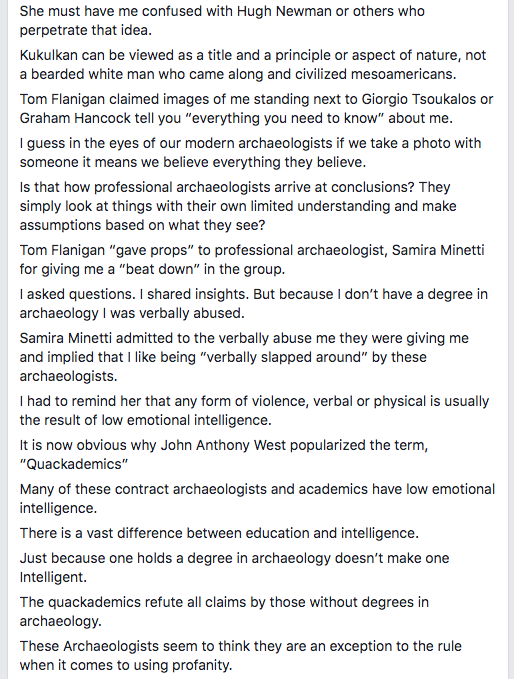
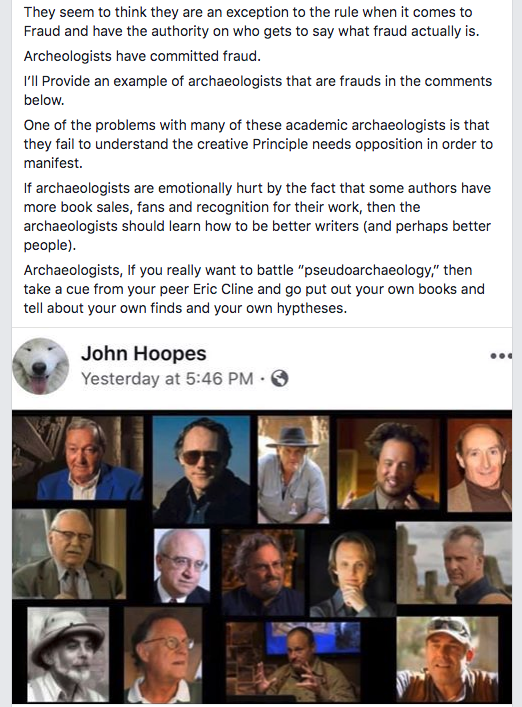
This post was my introduction to the situation. I went to investigate the page and requested to join. I was accepted in the group later that day. I looked through all the comments that started the debate and then found several other posts that followed, which were threads of nothing more than personal insults all directed towards someone that none of these people knew at all. I was shocked by how openly unprofessional the whole community was. It appeared as though 90% or more of the content on the site was made up of personal attacks on people rather then discussions of archaeology.
Normally I would roll my eyes to such a thing, but I could not, because I knew that in fact, these were the very ones who were convincing students of history to blacklist theories that have been proven worthy of debate. I was a personal friend of John Anthony West from 2006 until his death in 2018, so the baseless accusations against him were not only harmful to the world, but also HIGHLY offensive to me personally. Had I the time, I would have defended many of the other researchers represented in the image (to varying extents), but John was where both Anyextee and I chose to begin as John and Dr. Robert Schoch formed the most solid argument upon which much of the rest depended.
In response to this, I made my own post in the group:
“Wow. As a new member, I’m a bit shocked. I can’t claim to be an unbiased voice here, as I am admittedly a friend of Anyextee, and was a close friend of John West for well over a decade, but perhaps it is just this perspective that is lacking here.
If this group’s intention is to root out the ‘pseudo’ from the real, then respectful dialogue is how we make this distinction. Next stated that he encourages speculation, and in fact, he has done some of the best debunking in the business himself! He respectfully questioned whether West should have been lumped in with so many of the people he disagreed with – so many who were far below his level. Many of the pictured authors have indeed stretched the truth to fit their own narrative; to sell their books, though I don’t believe that any of them fabricated everything from scratch either. There is a spectrum of integrity. Some are better than others in this field.
Had I seen this post before NEXT, I would have said the same thing. There was not a single aspect of John’s work that could be considered fraudulent or misdirecting. As NEXT mentioned, he spent his last living months still writing – after he knew he had advanced cancer – was he just chasing book sales? No he wasn’t. I was with him, I know.
I’m not surprised to see John’s theories under attack. He spent four decades fighting these accusations yet the whole time, no one could refute him. Still today, when challenged, academia has backed away from the question. Next asked you all to describe why the Sphinx Erosion Theory is considered fringe or pseudo. No one did. Let me put it this way.
1> The courtyard surrounding the sphinx was, at some time, quarried out in blocks, many of which were used in the construction of the Sphinx Temple and Valley Temple. This much we know because we can match the layers of bedrock to the stones in the temples. Correct?
2> AFTER the excavation and construction occurred, the carved walls of the rectangular courtyard around the Sphinx were clearly exposed to prolonged ages of precipitation induced weathering. Nearly ALL the geologists that John showed this weathering to instantly agreed that it was due to prolonged rainfall, though often he would not tell them that they were looking at an image of the Sphinx courtyard so they would answer without bias towards his theory.
3> The blocks cut up and used in the Sphinx Temple, Valley Temple and the Sphinx itself all represent some of the most advanced stonemasonry in all of Egypt. (Size of stone, precision, etc)
4> THEREFORE, the Sphinx demonstrates that some of the MOST ADVANCED stonework in Egypt took place in an age long before the rains ended – LONG BEFORE DYNASTIC EGYPT.
The water erosion is found almost nowhere else in Egypt. The style of building – massive rectangular blocks with no reliefs or glyphs – is likewise found scarcely in Egypt (one exception being the Osireion, which arguably also comes from the same remote age). The Giza Pyramids also reflect this style and level of skill that could be taken to imply an entirely different civilization than Dynastic Egypt. What part of this can be denied? The blocks were lifted out of the ground, placed into a nearby construction, THEN and only then could the quarry wall have become weathered.
The rains were long gone by Khafre’s time. He didn’t build the Sphinx, he cleared the sand out and restored it. He gave it a renovation, put his plaque up and buried his statue there. Perhaps he was the one who re-carved the head, but this I personally doubt as well.
John demonstrated how weak the evidence was for attributing the Sphinx to Khafre and laid out an exhaustively thorough theory which explained things much better. In fact the logic is so simple that anyone can see it once they are shown. All it takes is common sense. The thing was cut, THEN it was weathered…
I’d like to be proven wrong here. I challenge anyone here to explain how the courtyard of the Sphinx was weathered by rain if it was built in an age when Egypt was already a dry desert?
I don’t think anyone here can deny that the weathering comes from precipitation (besides the fact that this question is for geologists, not archaeologists) OR the fact that the Sahara saw no rain for several millennia before dynastic Egypt even began.
So how can you argue that the weathered statue came from a time after the rains?
I feel like NEXT challenged you all, and you kept it civil for a moment… You asked the classic questions – recoiled into the baseline defenses. You asked for names and NEXT provided. You ignored his responses and when he pressed you for evidence of a single claim by West that could be possibly conceived as fraud, you all, amazingly, resorted to all different reviews and forewords written by others ABOUT John.
What does any of that prove?
And at what point did it have to degrade into a cultish personal attack on NEXT? Why did it dwindle down into this childish, high-school-cafeteria talk? What started as NEXT’s justified questioning of John’s placement in this category, and his insistence that maybe this was an unjust depiction, turned into a frenzy. Next answered all your questions and you did not answer his. Why should anyone be skeptical of West himself – of HIS OWN words, which he DID choose SO carefully?
Nobody said that West never used the word Atlantis, only that he was careful with it. He never claimed outright that Atlantis gave rise to Egypt. He only illustrated how obvious it is that our timeline is flawed – that something is backwards. Clearly the greatest architectural achievements in this land occurred in a time that classical archaeology just can not allow. He simply showed that this high wisdom came at an age long before the Pharaohs. He never claimed any definitive date for the Sphinx whatsoever. He openly postulated and he adjusted his beliefs as he continually learned more. He certainly demonstrated that it was NOT built in Khafre’s time.
He stepped in from left field and disrupted the picture perfect chronology that scholarship desperately fights to protect. Academia has always despised John Anthony West in the way that nobility, while praising the Emperor’s new robes, despises the child who says he is naked.
Don’t get me wrong, I do not mean to disrespect anyone here. I mean to come at this with reasonable questions and ask you, who clearly have views alternative to my own, how you somehow have the authority to discredit someone who most of you clearly were not all that familiar with from the start?
I’m just shocked to see that you ALL are now responding with laughter as though you’ve just served someone, when in fact, it really looks to me like y’all just got served. It’s just a bit shocking to hear the language on this feed and then to understand that it is all of YOU who believe yourselves to be the ‘professionals’ here. Criticizing the pith helmets? His name? [Anyextee’s] Critiquing his path as an entrepreneur? Asking who even has time to write these whole essays of response-comments – as if to CRITICIZE the care, attention and thoroughness he put into his responses?!?!
I don’t get it y’all. I think if you can dispute West and Schoch’s work, then come on and talk to me. If not, then you should probably all be a bit ashamed of yourselves. Just drop it with the grade school bullying. The personal attacks are making you all look like the fools.
West was light years beyond all this. I won’t bother to respond too often to situations like these. I can’t be offended, because I don’t have the desire to change your opinion. I don’t need you to believe what I believe. I’m not out to change your minds, but I’m willing to change mine if you can actually provide any evidence that John was fraud in any way. I just want those who are not entrenched in their views to understand that this opinion of John West as a “pseudo” is a baseless one.
Also, you must realize that the way you are using the term ‘pseudos’ to describe people is quite clumsy phrasing. You are effectively giving it the same meaning as the word ‘heretic’ or ‘terrorist’ – all of which literally translate to ‘the object of my smear campaign’ or ‘those I disagree with’. It is such a generalization that it is becoming meaningless. (ie. Why is he a pseudo? Because he supports all these other Pseudos! He’s pictured in memes with other pseudos, so he must be a pseudo! He shares the stage and screen with pseudos, so he’s a pseudo… See what I mean?)
Cheers everyone! The truth is out there…”
This was my post. I believe that this was a reasonable challenge to the ignorance I saw in this group and I became very excited to begin a debate. A few comments came in, beginning with a few people who were genuinely interested in John’s theory, and in response to these interested ones, I shared a link for John’s film The Mystery of the Sphinx and referred them to his book Serpent in the Sky.
Soon enough I got my first rebuttal, and though I do not have screen shots of any of these comments, I did copy and paste the first ‘rebuttal’ in full, and still have a copy, but for the most part, it is redundant regarding things and attitudes already discussed. There were many words, but no substance, and I simply illustrated this yet again. It concluded:
“They are called pseudo-historians/archaeologists because they sit in the lap of the *actual* archaeologists* who are doing the legwork, in order to spit in their face. So when you obviously screenshot this and pass it on to Mr. Next, tell him his hero-worship doesn’t actually get him anywhere. And P.S….another sign of a pseudo-historian is the constant use of the term, in many differing forms, of getting to the “truth”….something I see you haven’t disappointed by deploying.”
[Me]: “And there’s the personal feelings. Pure opinion. It is sad to note that you are offended by the term truth.
Well friend, thank you for your response. I appreciate your thoughts here, but you have not shown any evidence of John being a fraud, and you have not explained why the erosion hypothesis is ‘pseudo’. I would like to hear your further responses, and I have heard that many others have already begun commenting, but I’m off to bed. I look forward to this discussion tomorrow… Cheers.”

It was now around 3AM and I had noticed other comments coming in, but I assumed that I would have a full day of discussion ahead of me, and I was quite excited about it. I believe that I was being politely firm. One of the few comments I saw before going to bed was by Samira Minetti, who had been particularly active in stirring up aggressive commentators. She made a comment about how one of ‘Next’s minions’ was now trolling into the group. She tagged at least 4 individuals who had been involved in the previous drama, calling in her team. In all the comments I’ve seen by her, I would estimate that less than 5% actually address anything related to archaeology. Literally everything she wrote was completely unrelated to the topic, in ALL of these threads. It was all personal attacks on Anyextee and patting herself on the back for ‘verbally slapping’ his ‘pseudo arse’. She boasted and boasted about how she defeated him.
Is silencing someone and then slandering them when they are locked out of the room defeat?
I had taken the previous events as a clear sign that if the entire army of aligned ‘professional archaeologists’ had not been able to answer Anyextee’s simple questions, and then this whole mob decided to just remove him and replace debate with baseless, tactless slander – to me that looks like a forfeit. It looks like a win for Anyextee.
But apparently my post was also too much for the group to handle. When I awoke, I was banned from the group. I could not even find the page on facebook. Sometime around 10 am my post was deleted. I had written nothing more than what I have included here. I did not attack anyone, block anyone, or harm anyone. The only conclusion that I can draw is that this team had snuffed me out before this post had time to take off. They silenced me before I even had a chance to engage. I laughed it off. I knew when I posted it that they would attack me and find any way possible to misrepresent me.
Later in the day, I wrote to Samira and asked her to share a message to the group, which she did. She started a new feed, with more trivial name-calling. She had posted my request to be allowed back in to debate, but my original post was nowhere to be found, so my message implied that something was missing here. In fact in the first comments, someone asked what it was that they had missed. Samira responded as if she had no idea what had happened the night before – as if she herself had not blown the battle horn by calling in her gang! She played as if I had shown up in the group, whined and complained, and was thus kicked out. No one else there noted that, though I had implied that I gave the group a challenge, there was not a single word of mine up on the page, besides the screenshot of my message that she posted. Only one had the sense to ask – who was I? Samira’s disdain for me was the only reference that ANY ONE of these people had for me, yet they all happily jumped on the attack wagon…
In Samira’s introduction to my inquiry, she writes, “This bloke was one of Next’s minions, who was, breifly, a member here and started whining, complaining and promoting, lavishly, weird pseudo crap. I’m seriously wondering why the bloody hell he chose me, of all people, to send a message to? He should’ve messaged one of the admins here. #nextgate”
The truth is, the admins would never have done a thing, but I knew that Samira was obsessed by the drama and attention. I knew she would post my message in the group. Here is one of the comments showing Samira pretending not to have seen the whole thing happen the night before.
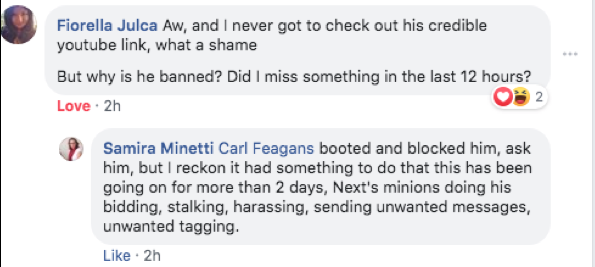
I did write to Fiorella Juica, who had commented that it seemed she had missed something. I sent her the post and offered that if she wanted she could share it to the page and allow for me to be represented fairly, but I did not hold my breath. I wrote to Feagans as well, asking why I was removed from the group, but he did not respond. I made a reasonable attempt to ask for fair representation in the group, but as is policy, the challenge was ignored and I was silenced. I felt that I had no alternative but to write this article in the hopes that others will understand that these individuals have a history of slander and that this specific social media group, is completely fraudulent itself.
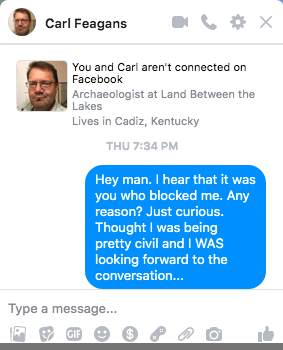
“Next’s minions doing his bidding, stalking harassing, sending unwanted messages, unwanted tagging.”
Anyextee had no idea I even wrote the post until it was published. I stalked and harassed no one, sent one message to Samira and I tagged no one. She was the one doing all the tagging and harassing! Learning more about this page, I realized that this is indeed their standard model. They share links of anything with the word debunk or fraud in the title and gloat about how smart and professional they are. When any of their scavenged debunkings are debunked themselves, they block the threat and revert to meaningless assaults on said subject. Within days, this same exact process happened to yet another fellow researcher and I could list several others who have received the exact same treatment from these very same people who represent the Society for American Archaeology! They are a gang of thugs; I know not how else to say it.
Samira many times admits that ‘blocking’ is a ‘pseudo tactic’, thereby labeling her own group as frauds themselves. These individuals have not given any great contributions to archaeology as a whole and they have not presented any breakthrough discoveries of their own. They spend their time calling names and forming exclusive clubs that overtly disregard evidence in front of their eyes. When they are challenged, they simply block the challenger out of the room and laugh about it. This is exactly the type of practice that defines pseudo archaeology in their own words. I would argue that everything needed to illustrate their own incompetence is made evident quickly within their own writings. If they were legitimate scientists, they would not be afraid to open these questions up to public debate, but rather, they choose to fight viciously to pin the public perspective against such theories. They engineer peer to peer censorship and thought-policing.
If one examines the day to day ‘debunking’ that goes on in Fraudulent Archaeology – Wall of Shame, and this is not enough to convince them that these attacks are unreasonable, there are many other papers by these authors that further evince this state of conditions. I would encourage the reader to become familiar with other interchanges between these authors and certain independent researchers and decide yourself who was actually attempting to ask the real questions and who was attempting to divert, discredit and deny without reasonable grounds.
John Major Jenkins, a well known specialist on the Maya and the Long Count Calendar who spoke a great deal about the 2012 date, responded to John Hoopes and Kevin Whitesides’ criticisms with a message they include in their paper:
I would argue that Jenkins successfully called out several of their own errors and they responded by evading the subject matter. They rely on the same few shaky arguments: guilt by association (with all the ‘new-agers’), guilt by lack of academic credentials, and otherwise sidestepping the central concern by saying that it was not what they were focusing on at the time.
“Jenkins is correct in saying that we “barely acknowledge” any scholarly efforts to reconstruct Maya belief systems. That was simply not the goal of our article…”
Yet, they denounce Jenkins’ work on these belief systems and disregard their importance within the study of the culture. Jenkins and I had conversed a bit regarding the ancient calendar before his passing in 2017, so once again I felt a personal connection to these attacks. Jenkins can not stand up and defend his own name anymore, so I would add him to the list of many whose legacies are at risk because of these ignorant allegations.
Though I do not wish to advertise these pages at all, I will encourage the reader to make their own choice. Here are a few others to peruse by Feagans:
https://ahotcupofjoe.net/2019/09/denisovan-origins-and-ancient-dna/
https://ahotcupofjoe.net/2019/04/the-pseudoarchaeology-of-america-before-a-review/
And here’s one that truly touched my heart, by Hoopes…

ATLANTIS THE SEAT OF MAN, By John Hoopes [Click here]
What has changed John Hoopes? Why do you no longer pursue the mystery of the past as you did in your youth? And knowing full well how all of your associates despise the word Atlantis, why have you chosen to keep this paper from 10th grade visible to all?
I feel sad for those who lack the confidence to question – who feel the need to claim they know the answer. I feel sad for all those who study history and fail to recognize the level of consciousness that prehistoric man very well may have achieved. I feel sorry for those who cannot handle the word ‘Atlantis’ or ‘esoteric’. I pray for those who have fallen into the cage of academic thinking – those who will not allow themselves to consider the alternatives, though their very livelihood depends upon a broken narrative. My heart goes out to those who are caught up and entrenched in programs that rule them – for they have lost their independence and their free will.
I can not comprehend how one could arrive at a way of thinking that compels them to spend their life telling others what books not to read.
What is that? Why would a person do that? If a theory is wrong then the public can decide for themselves. We do not need you to protect us from these ‘dangerous’ books.
I’m sorry for those who rely on writing textbooks and receiving royalties for such when they obligate their students to buy them; those who are now upset to realize that the rogues who chose the independent path have the liberty to enjoy the Indiana Jones style – that in which they may explore any region they wish and speculate freely as to the stones and relics they uncover. It is sadder still for the academician to witness these individuals often gaining more fame and publicity, because they are choosing to explore new and interesting ideas rather than rewriting the ‘orthodox doctrine’ year after year.
‘Speculation’ is among the most reviled words to you, but you must realize that it is in fact an essential aspect of science. Where would we be if Galileo, Newton or Einstein had never taken the time to imagine things as they may be, and let intuition guide discovery? Granted, there is a big difference between this and writing down a hypothesis that you will go to any lengths to prove, but nevertheless, science is a dead practice without speculation and imagination. Science has largely answered all the questions it can, within the box it is contained in. Now it is beginning to eat itself alive rather than leave the box.
And if such academics should take an interest in what they refer to as ‘fringe’ or ‘pseudo science’, they know that they will instantly be shunned by the cultish “Church of Progress”. They know that they are not allowed to say the word Atlantis, or even consider that someone even remotely associated with the term might have anything worthwhile to say at all. Is this science? To lock up scholars in boxes and let the idea police condition them into self-censorship and ultimately, nothing more than the preservation of a broken paradigm? While others are out there trying to answer real questions and being harassed for it?
And why is it that the scholars and scientists always give answers, while the independents tend more to ask questions? He who claims he knows is far less trustworthy than he who knows it’s only a claim.
I do not mean to scorn scholarship. I have a great respect for those who dedicate their lives to learning and teaching. Yet we must remember that in truth, we do not possess the ability to accurately date stone, so the truth is, no one knows the true origin dates of any of these sites – anywhere in the world! Any date you have ever been told by anyone, has been a guess based on carbon dated materials found in the region or else other contextual implications – THERE IS NO EXISTING METHOD TO DATE STONE ITSELF! Sometimes we can make a fairly accurate guess, when there is good deal of context, but NO ONE KNOWS. At least I see a lot more humility coming from the independents, who far more often acknowledge when an unknown is an unknown.
I didn’t enter this debate to start drama or change anyone’s mind. I recognized that the majority of these characters were openly criticizing a man whom I personally know to have been one of the most brilliant minds in recent history. They had no idea who he was beyond the basic talking points they’ve memorized, just in case someone should ever confront them with name John Anthony West.

John Anthony West ate pseudo-archaeologists for breakfast in his day, but sadly he is no longer with us.
I applaud Anyextee for standing against an army of ignorance as a solo soldier and I’m proud of myself for following suit. To be banned and criticized, and especially by these people (who have been attacking ALL the researchers shown in the original meme and many more…) makes me smile. I know now that I am truly following in John’s footsteps.
I had a feeling that this group would immediately silence me, but I had noticed a comment by a new member who admitted little awareness of the entire situation, yet chimed in that he was proud of everyone in the group for fighting against this (against me). I wondered how many people might stumble onto this page thinking that they will learn something, only to become quite misguided. Then I remembered that anyone with any sense would be able to recognize within minutes what exactly this page is – a support group for those who are too feeble to form their own conclusions, too enclosed to consider alternatives and too scared to enter thoughtful conversation.
The last thing I want is to merely attack back at these individuals, as I am a non confrontational person in general. I hope the reader will understand why I felt the need to share this story.
Above all else, it is my dream that one day, this war will end.
I was hesitant even to call it a war, as that is the last thing that it should be viewed as, though, lo and behold, that is what it is! I find myself on the defensive side – the only legitimate side of a war to EVER be on…
It is important to note that as far as I am aware, there have been very few attacks whatsoever, coming from the alternative schools aimed towards specific academics. True, they have challenged claims, and defences have been made when they were smeared, but in a sense, they have displayed far greater professionalism (perhaps because they are critiqued so much harder) then the academics in general, as they have refrained from ‘ad hominem’ attacks, or attacks aimed at the person rather than the issue at hand.
I want this all to be over and done with so that the world can learn its own history in peace and investigate these higher mysteries within a unified effort. Look how critically we are maiming ourselves right now!
It is my hope that those who are wrongfully trapped within this mechanism will find their way out. I hope that one day they will find the freedom to command their own discernment and pursue the investigations that are truly meaningful to them.
For those who are unwilling to face new insights and discoveries, I hope that some day, your minds may change.
And to every patient soul that made it the end of this article, remember that it is YOU who get to choose what to believe. Understand that these questions are far from answered and please, try to help build tolerance and patience within the universities, within the publishing houses and wherever else these questions arise. Let us collectively formulate, and consistently maintain, an intellectual environment in which all hypotheses are given fair consideration and all those conducting research are free of ‘belief limitations’ imposed by the fear of smear campaigns.
If you are a student currently enrolled in a university, then the power to effect this change is in your hands, more than any others. You could be the difference between humanity regaining ancient knowledge that is essential to our collective self awareness, and utter academic fascism.
Use your power righteously!
-OPVSMAGNVM MMXX
[Trevor Grassi]
